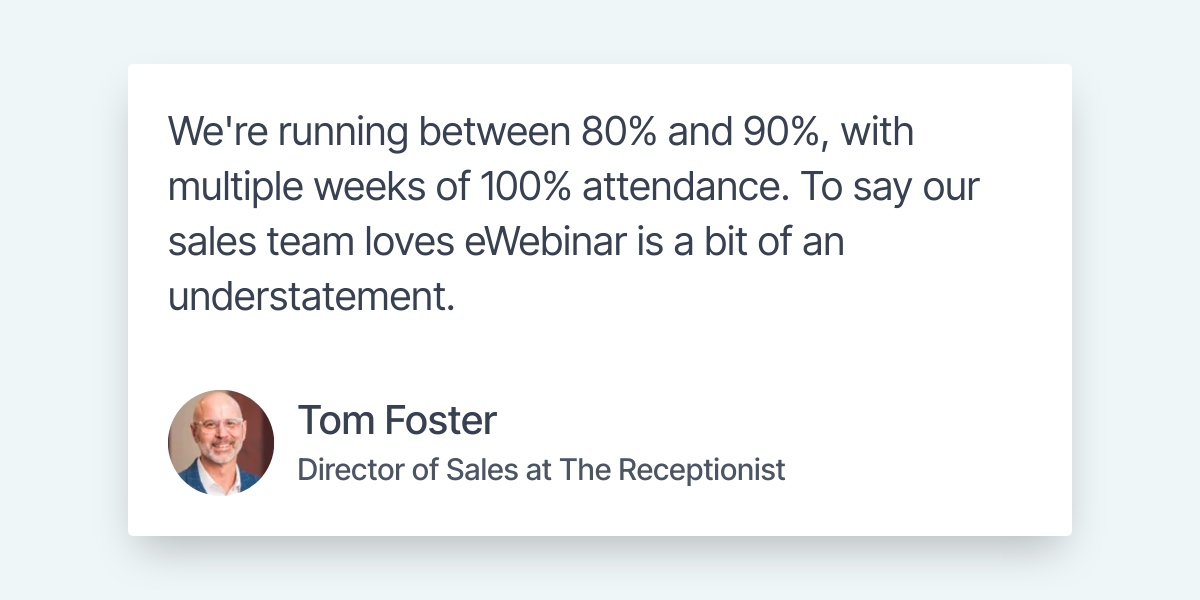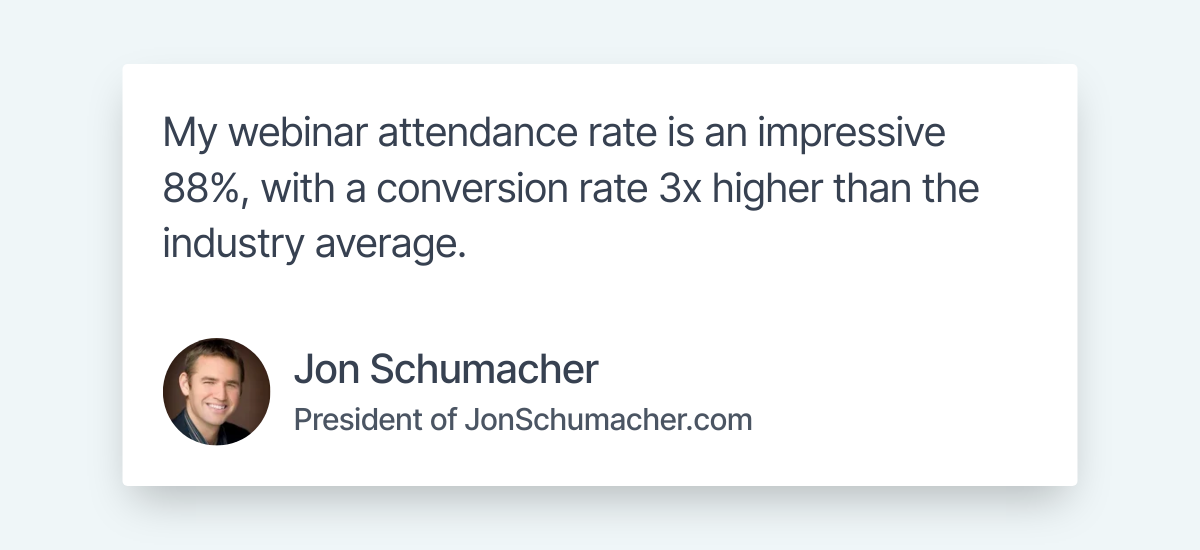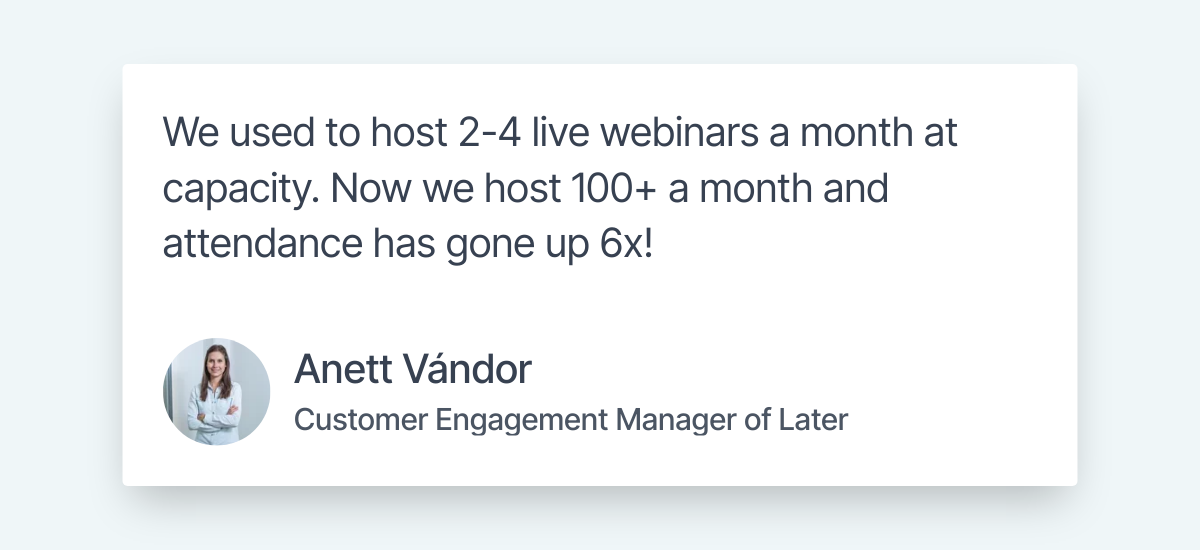BigMarker is known for having plenty of features and a high level of customization. However, this versatility creates a steep learning curve. As such, we've reviewed the 8 best BigMarker alternatives to help you find a more user-friendly solution.
Because BigMarker is a hybrid webinar platform — meaning it supports both live and automated webinars — we'll be segmenting our list of alternatives accordingly. Even if you're only hosting webinars live, we'd still recommend looking at the automated webinar alternatives to BigMarker.
Here are the top seven BigMarker alternatives for live webinars:
Here are the top three BigMarker alternatives for automated webinars:
In general, we’d advise against using a single platform for both live and automated webinars. Every hybrid platform we’ve tested turned out to really be a live webinar platform with some lackluster automation features tacked on after the fact.
Are you still hosting webinars live? There's nothing wrong with hosting a one-off event live but if you do recurring webinars (e.g. sales, demos, or onboarding) live then you'll be spending countless hours hosting the same presentation over and over until you burn yourself out.
If you're curious about how you can save time and double your attendance rate using automated webinars while providing a better-than-live attendee experience, watch our on-demand demo or skip to this section!


10 best BigMarker alternatives (live and automated)
BigMarker alternatives for live webinars
To start off, we'll give you an overview of the features, pricing, and reviews for seven popular live webinar platforms. This will help you find the best platform for your needs and budget while getting a sense of how satisfied their current customers are.
If you're looking for automated webinar platforms then click here to skip to the next section!
ON24
ON24 is a virtual events platform that lets you host webinars then promote them via personalized content hubs. Attendees can also ask you questions during events through the Q&A section or offer feedback after the fact using the post-webinar survey.
The webinar tool also helps sales and marketing teams score leads using metrics the number of webinars attended, total minutes watched, or total engagement score. Those who upgrade to the Standard plan or higher can even generate a custom leads report and see individual prospect profiles.
ON24 pricing
There are three ON24 plans to choose from:
-
Essentials. Includes webinars, event management, performance analytics, and 30+ integrations.
-
Standard. Includes segment personalization, advanced analytics, and AI-generated content.
-
Advanced. Includes personalized content hubs and registration pages.
Note: All three plans use quote-based pricing and charge extra for the virtual events add-on.
ON24 reviews
ON24 has a rating of 4.3 on G2 and 4.3 on Capterra.
Zoom
In addition to being a video conferencing platform, Zoom is also a webinar hosting platform (as long as you pay extra). Some interactive features are available on both Zoom meetings and webinars such as breakout rooms, hand-raising, or live polling.
You can also hold Q&As, send out post-webinar surveys, and stream Zoom Webinars to other platforms like YouTube or Facebook Live. Finally, the Zoom App Marketplace contains thousands of integrations, 350+ of which are available for webinars — such as HubSpot, Pardot, Zapier, and many others.
Zoom pricing
Zoom Webinars only has one plan starting at $79/month for 500 participants. Upon exceeding the 500-participant limit, the subscription price more than quadruples to $340/month and continues to increase as your audience grows.
Zoom reviews
Zoom Webinars has a rating of 4.5 on G2 and 4.7 on Capterra.
Webex
Like Zoom, the Webex Suite can be used for both meetings and webinars. Its webinar engagement features include polls, reactions, hand-raising, and Q&As. It can also handle as many as 100,000 concurrent attendees which makes it an appealing choice for large-scale online events.
Webex can also automatically remove the background of presenters, provide real-time captioning in over a hundred languages, and recognize their voice in order to filter out background noise more effectively.
Webex pricing
Webex Webinars is priced on a quote basis and doesn't list prices publicly on its website.
Webex reviews
Webex Webinars has a rating of 4.4 on G2 and 4.4 on Capterra.
Livestorm
Livestorm is a video engagement platform for live events and online meetings. It contains the usual features you'd expect from modern webinar platforms such as customizable registration forms, email sequence scheduling, and decent webinar analytics.
The virtual event platform also includes interactive features like Q&A or polls. However, they must be manually triggered by the host rather than scheduled to appear at a certain point in the presentation. That said, Livestorm does offer a detailed contact profile that would be useful for a sales team.
Livestorm pricing
There are three Livestorm plans to choose from:
-
Pro. Starts at $99/month for 100 attendees and a four-hour time limit.
-
Business. Uses quote-based pricing for up to 3,000 attendees and a four-hour time limit.
-
Enterprise. Uses quote-based pricing for up to 3,000 attendees and a 12-hour time limit.
Note: Livestorm has a free version with a 20-minute time limit and 30-person attendee cap.
Livestorm reviews
Livestorm has a rating of 4.4 on G2 and 4.7 on Capterra.
Zoho Webinar
Zoho Webinar is a relatively new player in the webinar industry that includes standard features like polling, screen sharing, and streaming your webinar to YouTube. It also lets you share registration links across multiple social media platforms then use the source tracker to see where registrants come from.
Hosts can also use GIFs as their virtual backgrounds, redirect attendees to a specific webpage at the end of the webinar, and see engagement levels for the audience as a whole. Finally, attendees can easily join webinars using the Zoho Webinar app for iOS and Android.
Zoho Webinar pricing
There are three Zoho Webinar plans to choose from:
-
Standard. Starts at $8/month for 25 attendees.
-
Professional. Starts at $16/month for 25 attendees.
-
Enterprise. Starts at $66/month for 500 attendees.
Note: Zoho Webinar has a free version with a 60-minute time limit and 100-person attendee cap.
Zoho Webinar reviews
Zoho Webinar has a rating of 4.5 on G2 and 4.4 on Capterra.
GoTo Webinar
While GoTo Webinar is more expensive than GoTo Meeting, it's able to handle more participants. GoTo Webinar also comes with extra features like remote control access so you can pass control of the keyboard and mouse to a co-presenter.
Its interactions include Q&As, polls, and surveys. You also have the option of including a certificate of attendance in your follow-up emails (which will only be sent to registrants who actually attended.) Lastly, you can use the GoTo Webinar video library to save and manage your event recordings.
GoTo Webinar pricing
There are four GoTo Webinar plans to choose from:
-
Lite. Starts at $59/month for 250 attendees.
-
Standard. Starts at $129/month 500 attendees.
-
Pro. Starts at $249/month 1,000 attendees.
-
Enterprise. Starts at $499/month 3,000 attendees.
Note: All subscriptions to the Standard plan or higher come with one GoTo Meeting license.
GoTo Webinar reviews
GoTo Webinar has a rating of 4.2 on G2 and 4.5 on Capterra.
Adobe Connect
Adobe Connect was built with meetings, webinars, and classrooms in mind. As such, it has audience engagement features like breakout rooms and quizzes that you can set time limits for. Attendees can also set their status to an action like "raise hand" or a request like "speak louder".
As for hosts, the real-time engagement dashboard shows webinar runtime, number of attendees, engagement rate, and poll results. Hosts can even see a dot next to each attendee that changes to green, yellow, or red depending on how engaged they are.
Note: Adobe Connect's mobile apps for iOS and Android average 3/5 stars due to their bugginess.
Adobe Connect pricing
There are three Adobe Connect plans to choose from:
-
Standard. Starts at $190/year for 100 attendees.
-
Premium. Starts at $290/year for 100 attendees.
-
Enterprise. Starts at $390/year for 300 attendees.
Note: Adobe Connect doesn't offer a monthly subscription, only annual licenses.
Adobe Connect reviews
Adobe Connect has a rating of 4.0 on G2 and 4.3 on Capterra.
BigMarker alternatives for automated webinars
After analyzing the data from millions of automated webinars on our platform and interviewing our most successful customers, we've found that three features determine an automated webinar's success: chat, interactivity, and scheduling.
As such, we'll be using these capabilities as the criteria to compare the three automated webinar platforms below. To start things off, we'll show you how eWebinar works and then explore how the other two platforms differ.
eWebinar
Watch this one-minute video for a quick overview of how eWebinar works or join our on-demand demo for a more detailed overview!


Pourquoi eWebinar se concentre à 100% sur les webinaires automatisés
Every hybrid platform started out as a live webinar platform that eventually tacked on automation features. Because automation wasn’t a core part of the product, these features always fall short.
When we were growing our previous SaaS company, we found ourselves stuck in the webinar hell of hosting the same onboarding webinar over and over again. After trying every webinar platform on the market and running into shortcomings each time, we decided to build our own.
eWebinar was built from the ground up with an exclusive focus on automation and is now the webinar platform we dreamed we had back then. With eWebinar, you record a presentation once then set it on autopilot without losing the ability to communicate with attendees.
You might still be wondering: can automated-only really be better than live or hybrid platforms?
Our customers respond with a resounding yes (both in their words and analytics).

Click here to see more customer case studies
Now let’s take a closer look at the three key features that make eWebinar stand out:
-
Chat en direct
-
20+ interactions
-
Flexbile scheduling
1. eWebinar lets you communicate with your audience through live chat and email
BigMarker's biggest drawback is the fact that you can't respond to questions after the webinar has ended. This means that you'll need to attend every session in order to chat with attendees — which defeats the point of automation.
On the opposite end of the spectrum, EverWebinar doesn't offer real-time chat at all meaning you'll have to reply to any questions submitted in the contact form after the webinar has already ended. Demio does slightly better with chat for recurring webinars (though you still need to attend every session) but not for on-demand webinars.
Instead of making you choose between chatting with attendees during the webinar or being able to reply to them after the fact, eWebinar gives you the best of both worlds by offering both live chat and asynchronous email!
Here's how eWebinar's chat system works:
-
Automated welcome messages. Attendees see a personalized welcome message as soon as they join the webinar. If no one's free to chat with them, an auto-response will set expectations on when they should hear back.
-
Instant message notifications. Once an attendee messages through the chat, you (and any moderators you've assigned) will immediately be notified through email, browser notifications, or Slack alerts.
-
Live chat + email responses. The host can then either reply to attendees in real using the live chat or respond later on via email. Any replies sent after the webinar has ended will automatically be sent to the email address they used to register.
eWebinar's chat was designed to ensure every message gets a timely response.
In fact, we ourselves use the chat to respond to attendees while they watch our on-demand demo (because we use eWebinar to demo eWebinar).


2. eWebinar's interactions engage attendees and increase watch time
Answering questions isn't the only way to engage attendees. eWebinar lets you add interactions like polls, quizzes, offers, and handouts that maximize watch time by keeping attendees engaged throughout the entire webinar presentation.
BombBomb managed to increase their watch time from 70% to 90% by adding interactions:

eWebinar offers the largest variety of interactions with 20+ different types to choose from.
Instead of manually entering timestamps for each interaction, our timeline editor lets you add them by just dragging the playhead to any point of the webinar and then choosing which interaction to insert:

To see what these interactions look like from an attendee's point of view, watch our on-demand demo!


3. eWebinar’s flexible scheduling doubles attendance rates
eWebinar’s flexible scheduling lets you record a presentation once then make it available as an on-demand webinar and automate it on a recurring schedule that adapts to the registrant's local time zone. This makes it as convenient as possible for registrants to attend your webinar.
That's why the average attendance rate for automated webinars hosted on eWebinar is 65% — which is much higher than the 40% industry average of live webinars. Many eWebinar customers exceed the platform average with attendance rates above 90%:


Others see even bigger gains, like Later who 6x'd their attendance after switching from live webinars to eWebinar:

If you want to make engaging webinars conveniently available to registrants at their peak moment of interest without having to host each session live then go watch our on-demand demo!


Demio
Demio is a hybrid platform that only supports live webinars on its entry-level subscription but does have automation features once you upgrade to the Growth plan or higher. It lets you create webinars with interactions like CTAs, polls, and handouts.
Its scheduling options include on-demand and recurring webinars. However, you won't be able to enable live chat for on-demand webinars which results in a somewhat passive attendee experience. As for recurring schedules, you can only schedule them at a fixed time rather than adapting their time zone.
Demio pricing
There are three Demio plans to choose from:
-
Starter. Starts at $59/month for 50 attendees and has a three-hour time limit.
-
Growth. Starts at $109/month for 150 attendees and an eight-hour time limit.
-
Premium. Starts at $184/month for 150 attendees and a 10-hour time limit.
Note: You'll need to upgrade to Growth or higher to use Demio's automation features.
Demio reviews
Demio has a rating of 4.6 on G2 and 4.7 on Capterra.
EverWebinar
EverWebinar has similar scheduling to eWebinar but takes a very different approach to its chat system. You have to choose between disabling chat, embedding a question box so you can reply through email, or using a simulated chat that doesn't even capture messages sent by attendees.
Using a simulated chat could damage the host's reputation once attendees realize it's fake while disabling chat entirely is worse still. This makes the question box the only viable option despite lacking the ability to respond to attendees in real time.
EverWebinar pricing
There are three EverWebinar plans to choose from:
-
Monthly. The monthly plan starts at $99/month which ends up being the most expensive option.
-
Yearly. The yearly plan starts at $499/year but you have to pay for an entire year upfront.
-
Biennial. The biennial plan averages out to $437/year but you're locked in for two years.
Note: EverWebinar doesn't offer a free trial, instead opting for a paid trial.
EverWebinar reviews
EverWebinar has a rating of 3.9 on G2 and 3.9 on Capterra.
Conclusion
As you can see, there are plenty of live webinar platforms to choose from. Zoho Webinar provides an affordable entry point, Adobe Connect has interesting features but suffers from a poor mobile experience, and Zoom wins the popularity contest but gets expensive fast.
However, when it comes to automated webinar platforms, eWebinar is the best automated BigMarker alternative. Our platform lets you chat with attendees both during and after the webinar, record a webinar once then automate it to run 24/7, and keep attendees engaged with 20+ interactions.
If you're still on the fence then see eWebinar in action for yourself by watching our on-demand demo!










